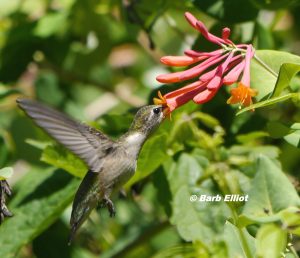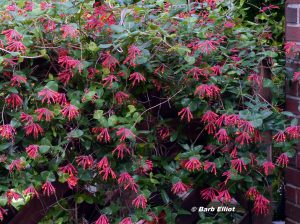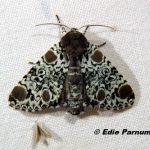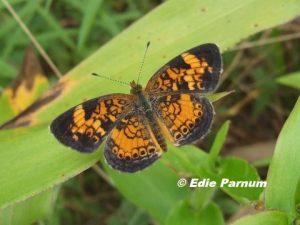by Edie Parnum
Every year we feature two superior native plant species. One of the Prime Plants for Nature is a Tree, Shrub, or Vine and the other is a Perennial. Prime Plants are selected based on these criteria:
1. Native to southeastern Pennsylvania.
2. Offer high wildlife value and contribute significantly to your property’s web of life.
3. Provide food for wildlife by producing nutritious fruits, seeds, nuts, nectar, or pollen. Most host insects that are eaten by birds or other animals.
4. Offer shelter and places to raise young.
5. Easy to grow and make attractive additions to your landscape.
6. Sold at native plant nurseries and native plant sales.
Our selections for the 2017 Prime Plants for Nature awards are:
Trumpet Honeysuckle, Lonicera sempervirens
Wildlife Value: Red tubular flowers on this woody vine produce nectar that attracts and

Female Ruby-throated Hummingbird feeds on Trumpet Honeysuckle nectar. © Barb Elliot. Click to enlarge.
nourishes our Ruby-throated Hummingbirds. Butterflies and bumblebees use the nectar and pollen. As with other native plants, the foliage is food for native caterpillars, including Spring Azure butterflies and moths such as Hummingbird Clearwing (Hemaris thysbe), Snowberry Clearwing (Hemaris diffinis), Harris’ Three-spot (Harrisimemna trisignata), and Great Tiger Moth (Arctia caja). These caterpillars in turn are food for birds and their nestlings. Songbirds occasionally eat the red berries.
Growing Conditions: Trumpet Honeysuckle is adaptable to a variety of situations, sun or part sun, dry to moist soil. This twining vine is best supported by a trellis, fence, or arbor. The plant is long-lived and usually not bothered by pests or disease. Fertilizer is not recommended.
Appearance: This honeysuckle is a rapidly growing multi-stemmed vine but isn’t invasive. The attractive, clustered 2” tubular flowers are red with a yellow throat. They bloom, sometimes profusely, from May through late summer.
New England Aster, Symphyotrichum novae-angliae
Wildlife Value: Many bees and butterflies use the pollen and nectar of New England
Aster flowers. Sweat bees, leafcutter bees, carpenter bees, mining bees, and bumble bees are attracted to the blooms’ bold, contrasting colors. The flowers are an important nectar source for Monarch butterflies during their fall migration. The foliage hosts 109 species of caterpillars (per Doug Tallamy, Bringing Nature Home: How You Can Sustain Wildlife with Native Plants, 2007) including the Pearl Crescent butterfly. Moth species include Saddleback caterpillar, several geometers, and Brown-hooded Owlet.
Growing Conditions: This trouble-free perennial grows in moist to average soil with sun or part sun. The parent plant produces seedlings that can be easily transplanted. Mature plants can be divided and transplanted, too. Mildew can develop with high humidity and poor circulation.
Appearance: New England Aster is one of our prettiest native perennials. A profusion
of brightly colored blossoms, each 1 ½” across, appears in late summer and persists until fall. The flower rays are bright pink or purple, the central florets yellow-orange. The plant grows 3-6 feet high and may require staking. In a small garden, keep the plant from getting too tall by pinching back the top growth in early June and then again in early July. The flowers are attractive additions to flower arrangements. Cultivars are available in a variety of colors and heights.






Great picks. Lonicera seems to bloom forever, late-March through end of summer on my pergola, and is definitely a hummingbird magnet when they first arrive. This and crossvine are my top choices for a pergola/arbor since neither gets out of control. I’ve never experienced mildew with straight species Symphyotrichum novae-angliae or S. oblongifolium. Both are great with goldenrods, of course, but I mix mine in with mid-summer bloomers to keep the color going once the summer blooming flowers are spent. Incredible amount of pollinator activity around these in late fall.